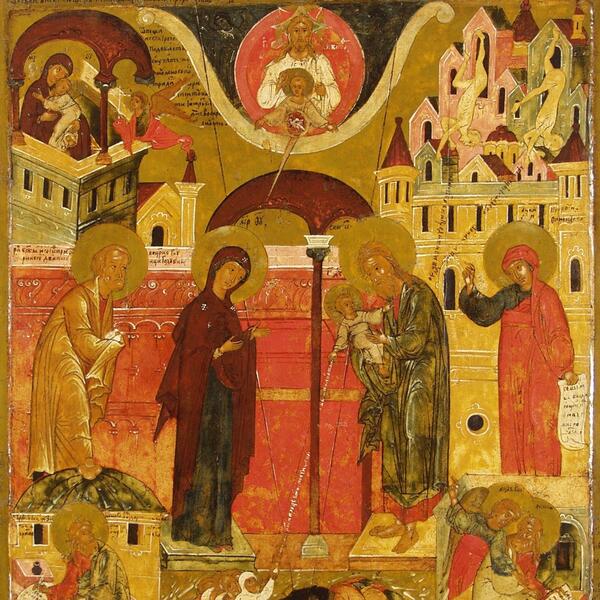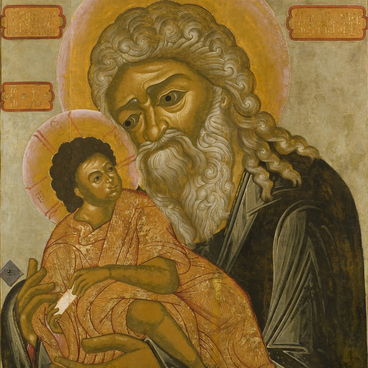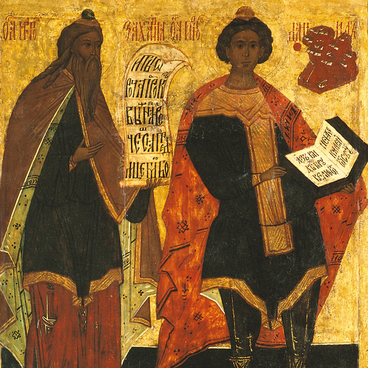The Presentation of Jesus Christ, or Candlemas, was first celebrated by the Jerusalem Church in the 4th century. It was not a separate feast but rather the celebration of forty days after the Epiphany. According to the Holy Scripture, it was the day when Saint Joseph and the Virgin Mary brought their Child into the church to offer a sacrifice for his birth. Although Mary had not known sin, she decided to observe the Law and undergo an act of ritual purification. After that, all the rituals according to the Law of Moses were also performed for Jesus. This asserted his incarnation. This is also emphasized by another detail — the Child’s bare feet that were not covered by a short shirt.
At the church, they were met by Anna the Prophetess and Saint Simeon, also known as the God-Receiver. During the reign of the Egyptian ruler Ptolemy II, Simeon was translating the Book of Isaiah from Hebrew to Greek. He doubted the words “a virgin shall conceive, and bear a son” and wanted to correct this “error”. However, an angel stopped him from doing that and announced to Simeon that he would meet Christ the Lord himself. Inspired to come to the church on the 40th day after the birth of Jesus, the old man recognized the Child as the Messiah, received his blessing, delivered a prophecy to Mary, and died peacefully the very same day.
This icon is based on a long text inspired by festive hagiographic readings. The style of painting indicates that it might belong to the Stroganov school of the late 16th century.
The main image is complemented by additional scenes: the bottom left corner shows Isaiah writing his Book of the Prophet, and the bottom right corner portrays Simeon the God-Receiver working on the translation of the Book. They are depicted facing each other as if engaged in a wordless conversation. Another implicit conversation is going on between the Holy Trinity of the Paternity style depicted at the top center and the jaws of Hell at the bottom. Righteous men wearing white clothes rise from the jaws of Hell, praising God, while sinners fall into the darkness together with the devil. The upper left corner shows a miniature image of the Passion Mother of God where the angel tells her about the future Passion of her Son. In the upper right corner, the painter depicted the falling figures, or the downfall, of pagan idols as a result of the predicted Passion of Christ. All of these meanings combine into the image of a common and comprehensive design of God.
At the church, they were met by Anna the Prophetess and Saint Simeon, also known as the God-Receiver. During the reign of the Egyptian ruler Ptolemy II, Simeon was translating the Book of Isaiah from Hebrew to Greek. He doubted the words “a virgin shall conceive, and bear a son” and wanted to correct this “error”. However, an angel stopped him from doing that and announced to Simeon that he would meet Christ the Lord himself. Inspired to come to the church on the 40th day after the birth of Jesus, the old man recognized the Child as the Messiah, received his blessing, delivered a prophecy to Mary, and died peacefully the very same day.
This icon is based on a long text inspired by festive hagiographic readings. The style of painting indicates that it might belong to the Stroganov school of the late 16th century.
The main image is complemented by additional scenes: the bottom left corner shows Isaiah writing his Book of the Prophet, and the bottom right corner portrays Simeon the God-Receiver working on the translation of the Book. They are depicted facing each other as if engaged in a wordless conversation. Another implicit conversation is going on between the Holy Trinity of the Paternity style depicted at the top center and the jaws of Hell at the bottom. Righteous men wearing white clothes rise from the jaws of Hell, praising God, while sinners fall into the darkness together with the devil. The upper left corner shows a miniature image of the Passion Mother of God where the angel tells her about the future Passion of her Son. In the upper right corner, the painter depicted the falling figures, or the downfall, of pagan idols as a result of the predicted Passion of Christ. All of these meanings combine into the image of a common and comprehensive design of God.



